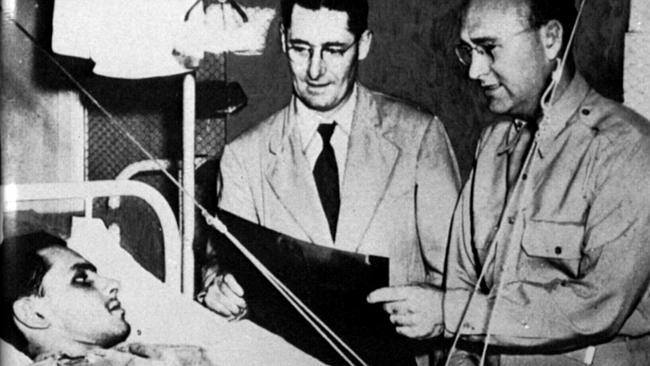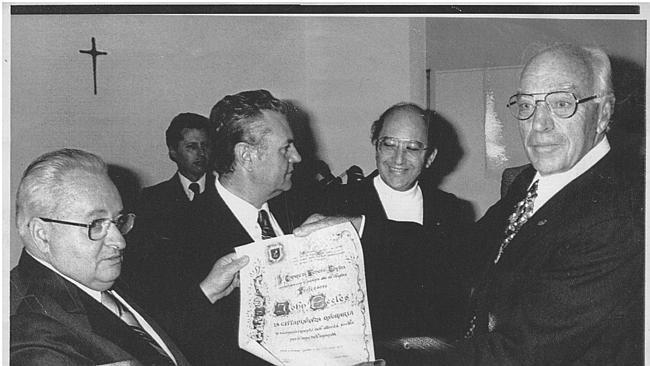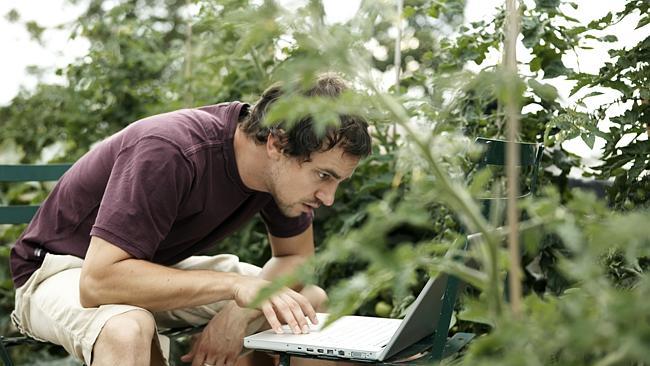Top 50 Ahead of the Curve: Science
JAMIE Seidel looks at leading lights from the world of science.

Top List
Don't miss out on the headlines from Top List. Followed categories will be added to My News.
They're the people and products that broke new ground, the innovators that changed their fields and the way we live. In this first chapter of a series celebrating pioneers, Jamie Seidel looks at leading lights from the world of science.
William Henry and William Lawrence Bragg
X-ray spectroscope

Have no idea what the x-ray spectroscope is, but are impressed with the strength of your mobile phone’s glass screen? You have Sir William Lawrence Bragg, pictured, and Sir William Henry Bragg to thank. This father-son team won the Nobel Prize for physics in 1915. It was their invention of x-ray analysis devices which led to breakthroughs in understanding crystalline structures which, in turn, led to better manipulation of metals and other materials.
Sir Howard Florey
Antibiotics

The lifesaving power of antibiotics is taken for granted in the modern era. But, in the time of Sir Howard Florey, a simple infected cut could result in death. While Florey shared the 1945 Nobel Prize for medicine with Ernst Chain and Sir Alexander Fleming, he was nevertheless recognised for his key contribution to the discovery of penicillin and the enormous effect the subsequent field of antibiotics has had on healing infectious diseases. Florey is pictured here, centre, examining a wounded soldier undergoing penicillin treatment in New York in 1944.
Dr Graeme Clark
Bionic ear

In one of the first victories of technology over the human body, Dr Graeme Clark believed hearing could be restored in some people if a faulty ear was simply bypassed and the nerves associated with hearing artificially stimulated. His resulting cochlear implants have, since the 1970s, opened up new opportunities for millions of people around the globe. Clark is pictured here in 2005 with young cochlear implant recipients.
Sir John Eccles
Synapse discovery

Neurophysiologist Sir John Eccles, picured right, helped push back the boundaries of understanding the human brain. In particular, his most important contribution was discovering the functionality of the synapse — the chemical junction between two neurons or a neuron and a muscle. Eccles went on to determine how motor neurons needed the input of several sensory neurons before “firing”. Such “on-off” switches are at the very core of our brain’s functionality.
Peter Doherty
Immune system

Boosting immunity is the alternative-medicine mantra. Compromised immune systems are the bane of modern medicine. But the existence and role of the body’s method of fighting viruses is known thanks to Peter Doherty. Viruses infect and reproduce inside host cells. “T” cells attack infected cells to kill the virus. While his work was done back in 1973, Doherty was recognised for his achievement with the Nobel Prize for medicine in 1996.
Frank Fenner
Smallpox vaccine

The disfiguring viral disease Smallpox has all but been eradicated thanks to the insight of Australian scientist Frank Fenner. After developing pox vaccines in mice, he went on to work with the World Health Organisation to isolate outbreaks and vaccinate surrounding populations. Despite being officially eradicated in 1979 as a result of Professor Fenner’s work, the disease is believed to have claimed about 400 million lives during the 20th century.
Sir Mark Oliphant
Nuclear fusion

Australian physicist Sir Mark Oliphant was a key contributor in the first successful attempt to initiate nuclear fusion. The world’s nuclear industry is an offshoot of this original research. In World War II, he went on to demonstrate that nuclear weapons were both possible and achievable — before helping the highly secret US program to develop such devices.
John O. Limb
Digital video

Enjoy watching your favourite movies and TV shows downloaded to your PC or tablet? You have Australian electrical engineer John O. Limb to thank for that. His work on investigating the quirks of human perception led to experimenting with the coding of optical signals in the late 1970s and 1980s. His research is in many ways the foundation upon which the whole industry was based.
Brian Schmidt
Expanding universe

It’s big picture, but the Big Bang Theory got a shot in the arm after Australian Brian Schmidt and Adam G Riess — along with Saul Perlmutter — were awarded Nobel Prizes in 2011 for their work in determining that the universe is, in fact, expanding. They demonstrated this by measuring distant supernovae. “In 1998, cosmology was shaken at its foundations, as two research teams presented their findings,” the Nobel jury said of their work.
CSIRO
Wi-Fi

The world seemingly runs on the ability of mobile devices to communicate with each other through walls and across fields. But this was regarded as impossible before Australia’s CSIRO radio astronomers decided to turn their eye to a problem closer to home. Five billion Wi-Fi devices and $430 million in patent royalties later, the application of this technology seems to have no bounds.
Falling for the detail
Samsung LED TV 8000 offers Micro Dimming Ultimate for great picture quality

The Auto Depth Enhancer may create a feeling of depth and immersion when viewing some content – feel yourself falling into the action. Experience for yourself, the stunning detail and vivid colours enhanced by the contrast between dark blacks and bright whites. Samsung’s Micro Dimming technology constantly analysers zones of the onscreen image and controls LED brightness supporting picture quality.
Sponsored


